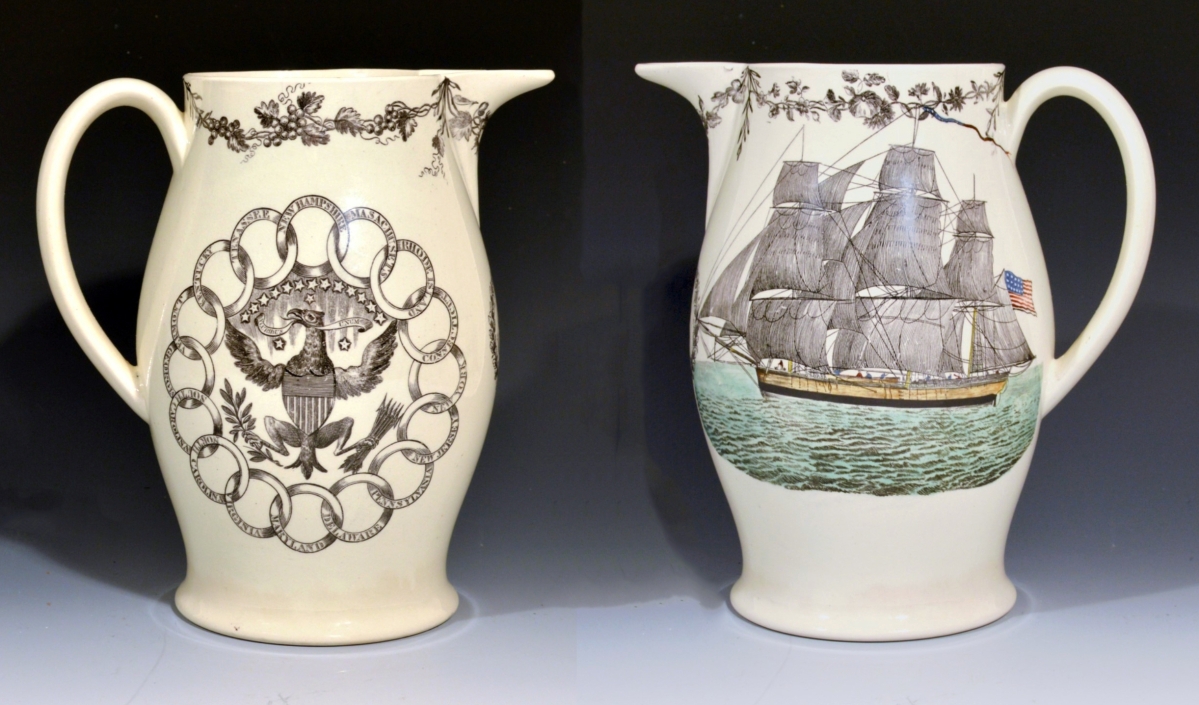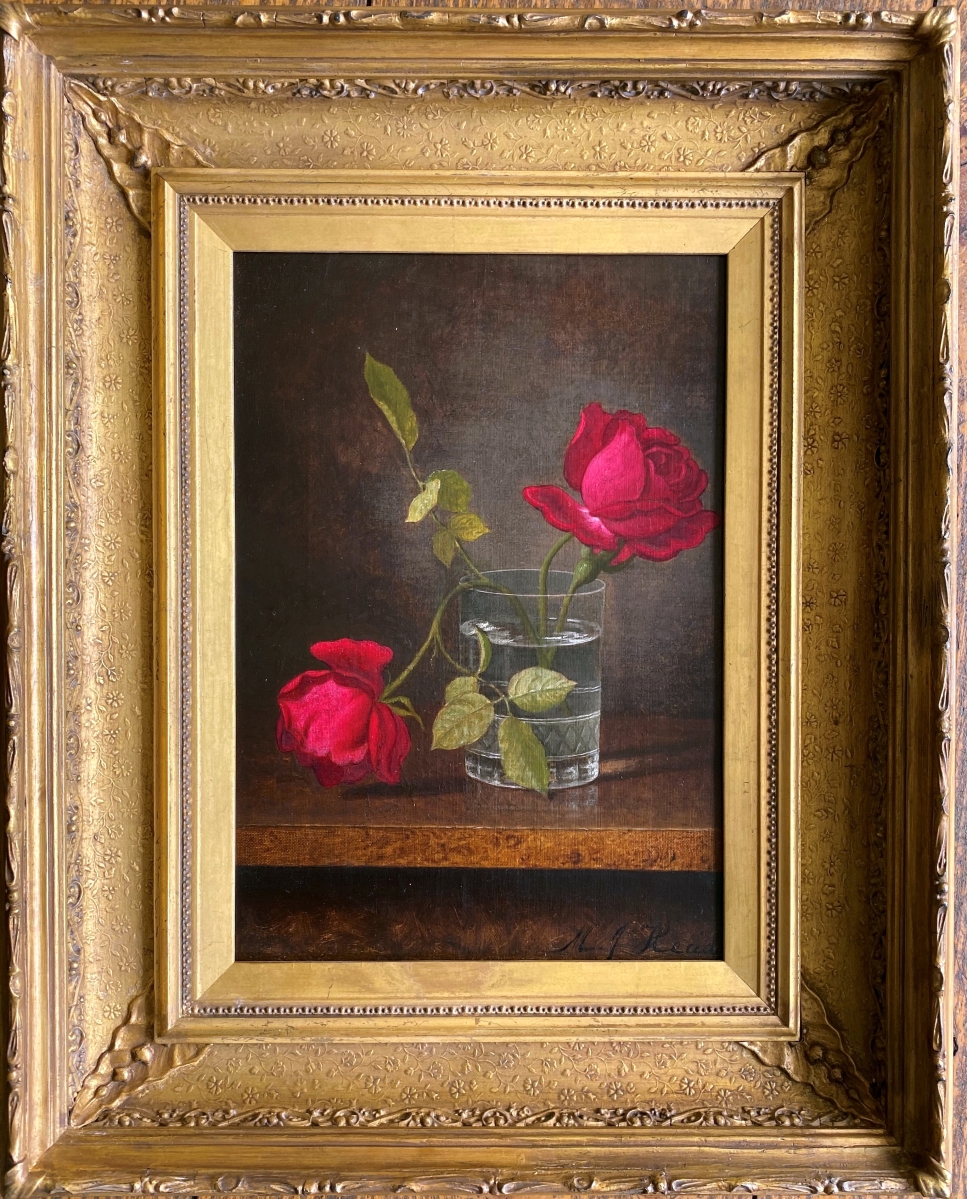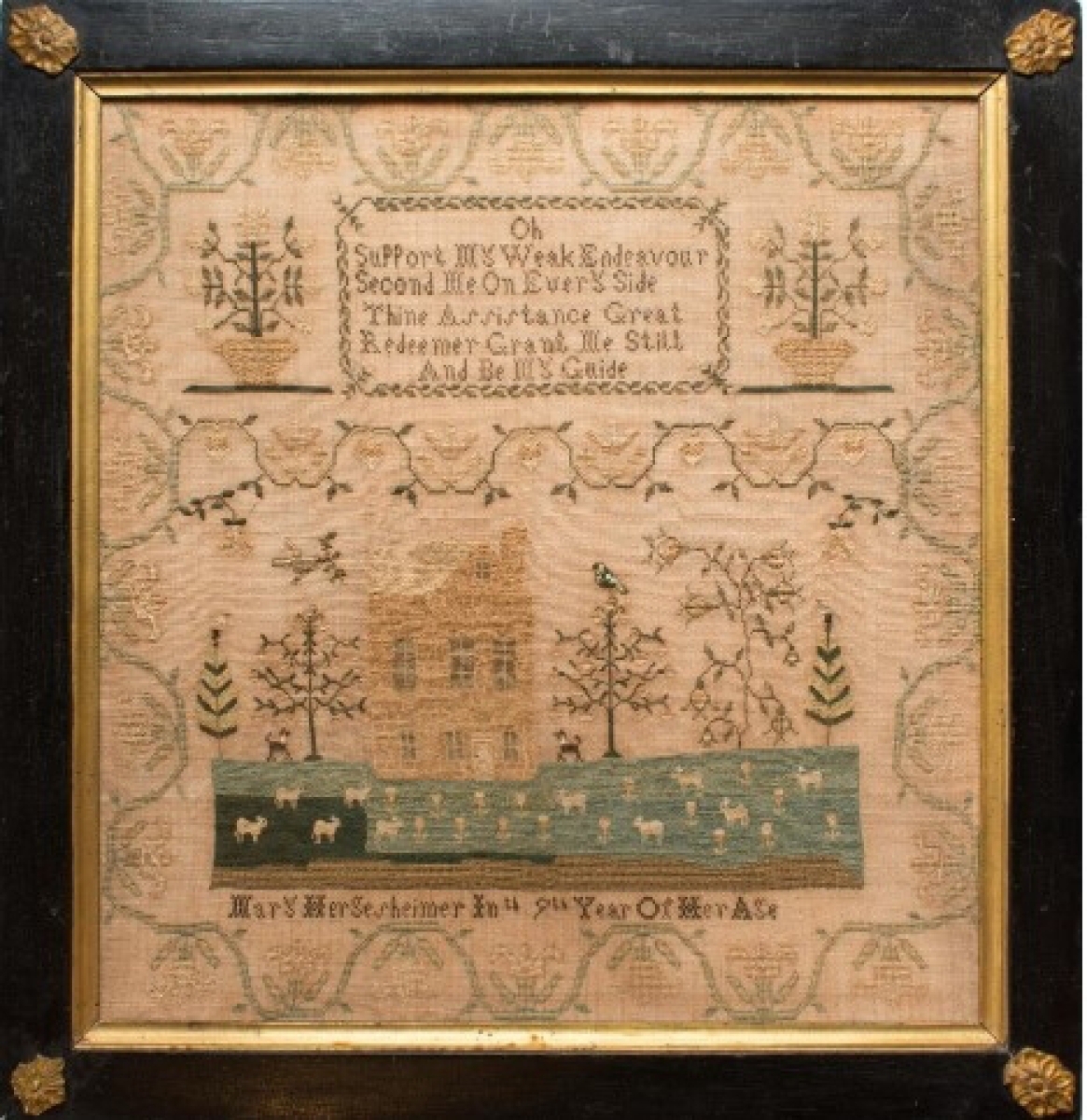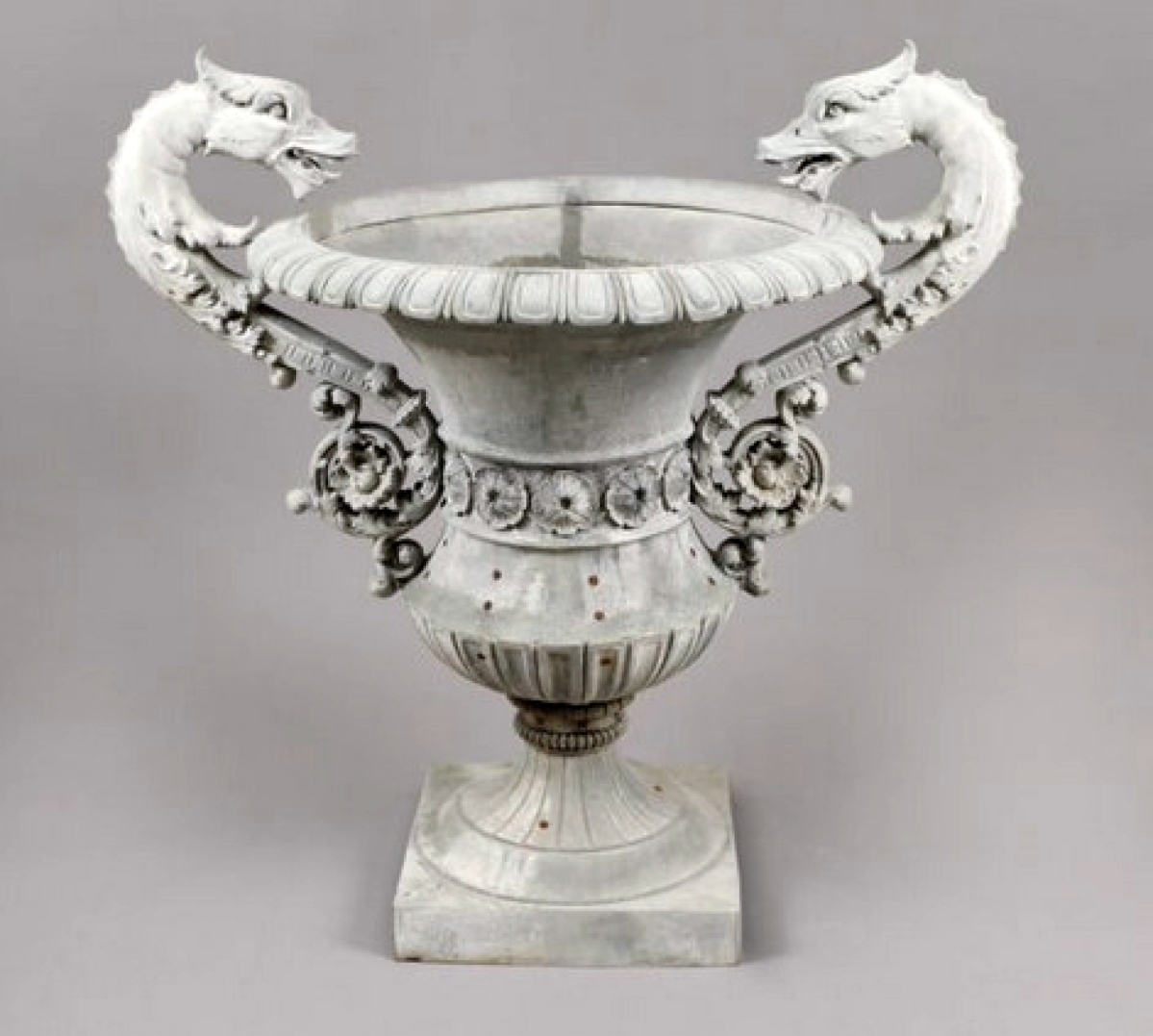
One of several sales by David A. Schorsch and Eileen Smiles American Antiques, Woodbury, Conn., was this portrait of Maria Rachel Munsill Bronson and her son, Wilber M. Bronson, done in Winchester, Conn., in 1852 by Ammi Phillips (1788-1865). One of only a small number of double portraits done by Phillips, the work had provenance to not only the collection of Jon and Rebecca Zoler of Ridgewood, N.J., but also the collection of Jane and Gerald Katcher of Aspen, Colo.
Review by Madelia Hickman Ring, Photos Courtesy Incollect
PHILADELPHIA & ONLINE – The online edition of the Philadelphia Antiques Show wrapped up at 6 pm on Thursday, May 28, after being on the Incollect platform from noon EST on May 14. The live show, which had originally been scheduled to take place at its customary time at the end of April to benefit the Philadelphia Museum of Art, was canceled in mid-March and the decision to hold a virtual edition was made between then and April 16, when an advertising commitment to Antiques & Fine Arts magazine had to be made. Exhibitors for the live show were refunded their fees so the show organizers, led by show manager and museum liaison, Huntley Platt, had just a few short weeks and very little money to pull off an online edition of what has traditionally been heralded as one of the premier annual antiques shows in the United States.
“Karen DiSaia connected me with John Smiroldo, who said Incollect would be interested in partnering with us and providing us with a platform,” Platt said, explaining the course of events leading up to the online edition to Antiques and The Arts Weekly by phone a few days after the show closed. “We frankly had no budget for advertising; most of it was digital. We posted on Facebook and Instagram, sent out e-blasts to past show supporters and attendees, and mentioned it in a newsletter that went to Philadelphia Museum of Art members.”
“I’m so grateful to John and Incollect that they were able to make it happen,” Platt said after the show. “After having canceled the April 2020 show due to the pandemic, we were fortunate that Incollect was able to provide a platform for the show dealers quickly and at a deep discount. The online show has been an amazing collaboration of individuals who are passionate about bringing fine art and antiques to viewers near and far. We were overwhelmed by the number of unique viewers. At just shy of 30,000, it was an incredible turn out!”
Platt, who began working with the Philadelphia show organizers in the fall of 2018, explained that the two-week duration of the show was a compromise. “I polled all of the dealers who had been slated to do the live show. It was really interesting; almost without variance, the antiques dealers wanted a short show, maybe a week, while the fine art dealers wanted a longer, month-long show. We had to consider all of our dealers.”
Of the 60 dealers who were originally contracted to participate in the live event, 48 signed on to do the virtual edition, five of which were entirely new exhibitors to the show. These were Alexandre Gallery, New York City; Gratz Gallery and Conservation Studio, Doylestown, Penn.; Questroyal Fine Art, New York City; Schmidt-Dean Gallery, Cherry Hill, N.J.; and The Tolman Collection, New York City.

Kelly Kinzle found a new home for this circa 1790 Chippendale walnut and white pine corner cupboard attributed to Frederick, Md., based on the combination of Anglo and Germanic decoration, which combined with Scottish inspired inlay patterns. It had descended in the Rosencrantz family of Frederick, Md. New Oxford, Penn.
More than 100 people registered for a virtual panel event at 6 pm on Tuesday, May 26, that was organized by the Philadelphia Museum and the New Antiquarians. Titled “American Beauty,” exhibitor panelists Kevin Tulimieri (Nathan Liverant and Son), Laura Adams (Avery Gallery) and Matthew Imberman (Kentshire) discussed learning about American-made objects and starting a collection with New Antiquarians co-founders and panel hosts Michael Diaz-Griffith (executive director, Soane Foundation) and Ben Miller (S.J. Shrubsole).
All in all, the 48 dealers offered a total of 1,300 items, with a maximum of 30 items per exhibitor. By the time the show went offline the evening of May 28, a total of 49 items had been marked as sold with an additional five items identified as “on hold,” though delays in conveying sales to Incollect to update sale status indicate that there were a few additional sales not included in these numbers. Google analytics identified that of the nearly 30,000 unique visitors to the show website, the demographics were split 60/40 female/male, and 46 percent being 44 years old or younger and 54 percent being 45 years old or older. Unsurprisingly, most of the visitors – 68 percent – were from the United States, with the rest of the show viewers from the United Kingdom, Canada, Italy and France.
While the look of the Incollect website generally received positive feedback, several dealers expressed dissatisfaction with searching capabilities and how the website operated. When Antiques and The Arts Weekly followed up after the show with Incollect president and founder, John Smiroldo, we broached the topic with him. He had been aware of the problems and pledged significant changes were in the works that would improve the platform. Promotion of the show was primarily digital, including email campaigns, large banners on the Incollect page and paid advertising on both Facebook and Instagram, with print advertising in Antiques and Fine Art magazine. Smiroldo also said Incollect created individualized social media content for each exhibitor to use in self-promotion.
Smiroldo was upbeat. “The Philadelphia Show online was exceptionally well received, particularly considering the limited time we all had to put it together. It drew significant traffic and major sales occurred. Dealers worked hard throughout the year to find incredible pieces to exhibit, and collectors anxiously anticipated the show, so it was important for the show to continue. The benefits of an online version of a show are now clearly evident, and I’m certain when the shows open again, most will have an online component to complement the physical shows. We’re soon releasing a new, more robust online platform for shows to use, utilizing the Incollect engine, that will truly enhance the online experience. We’re excited for the future.”
Woodbury, Conn., dealer David A. Schorsch tallied nine items, five of which had been sold in the first few days of the show. Commenting via email the morning after the show closed, Schorsch said, “We were genuinely surprised and encouraged by the outpouring of interest in the items we presented for sale in the first online edition of the Philadelphia Show. In a more narrowly focused presentation, it mirrored the positive reaction that we have experienced at the Philadelphia show over the last several years. In all we sold nine items that ranged from a Lehnware cup to an important Ammi Phillips portrait to a combination of new customers and longstanding clients who regularly support this show. We commend our colleagues, the management of the show and our friends at Incollect for all quickly innovating to make it go forward online under the pressure and stress of the present circumstances. Despite the present challenges to our daily lives, it is heartening to see that the beauty and history of antiques continue to bring pleasure to so many people.” When asked if he had utilized social media to promote the show, he said, “we did promotion on Facebook, Instagram and we sent announcements and offerings via email. All of this happened on the fly and I think everyone was doing what they could.”

Creamware American-market ship jug with 16 state ring design with eagle on the reverse, probably Herculaneum, Liverpool, England, circa 1800. Earle D. Vandekar of Knightsbridge, Downingtown, Penn.
Social media exposure also gave a boost to Taylor Thistlethwaite, who ticked off four sales, notably a Federal Baltimore inlaid sideboard, a Norfolk, Va., cellarette, a Salem, Mass., settee and a molded copper weathervane. The dealer, who has recently moved to Upperville, Va., commended Incollect and the Philadelphia Show organizers for pulling the show together on such short notice, adding, “Social media is a great way to expose material. I did not make any new contacts but was very fortunate to sell some furniture and I am glad there are online shows. Previously, online shows weren’t essential but that has changed and, as a show dealer, any attempt to figure out what works and what doesn’t is critical to me.”
“We fielded lots of questions from people who are not regular visitors to Nathan Liverant. Putting our objects onto the Incollect platform went very well and their staff was very good.” Colchester, Conn., furniture and folk art dealer Arthur Liverant also tallied a few sales, including a tall chest with vibrant geometric inlay, possibly made by Harrison Webber of Reading, Penn., around the turn of the century; it went to a person Liverant had known but who had never purchased from them before. Of similar vintage was a double-sided Art Nouveau trade sign in oil paint on zinc inscribed “Dr. Fuller, Private Diseases,” twice-signed by the maker, C. Miller of New York City found a new home with new clients, as did a mid-Nineteenth Century fancy red and black grain-painted and stencil decorated tulip poplar sewing box with vibrant fruit, flower and bird decoration from New England. When we asked Liverant about his social media presence, he said his shop manager, Ellen Sharon, sends out frequent email blasts and has been editing the firm’s archive of forums to post to YouTube while Kevin Tulimieri is on Instagram often.
“People had looked at some of the things previously, but being online prompted them to buy,” Kelly Kinzle, New Oxford, Penn., said of two large pieces of furniture he sold. A paint-decorated step-back cupboard from Lancaster County, 1840, which retained its original grained and smoke decoration as well as its original cream paint on the interior was marked as sold within the first day. Towards the end of the show, he wrote up an architectural corner cupboard that descended in the Rosencrantz family from Frederick, Md., featured decorative elements with several cultural influences, including English and Germanic, as well as Scottish-inspired inlay patterns. Kinzle was happy to say that after the show he had closed the deal on a Pennsylvania stoneware pitcher made in 1875 by Richard Remmey. It had cobalt decoration of George Washington and was inscribed on the bottom “Coaquanock Lodge / No 463 100F,” referring to a Masonic Lodge in Philadelphia. He said he was stepping up his use of social media and was happy to report a new client.
New Hope, Penn., and New York City dealers Edwin Hild and Patrick Bell of Olde Hope sold a carved cutting board with a heart-shaped handle on the first day of the show and, by the time it closed, had a buyer for a trapezoidal pine herb drying rack. Ed Hild said that the cutting board sold to an existing client but that they sold things from their website to new clients who found them through Incollect. Hild thought the website was fairly easy to navigate, saying additionally, “the (Incollect) platform was an important avenue for the museum to use; otherwise (the show) would not have happened. We give Huntley (Platt) a lot of credit; she was basically a one-man show.”
American furniture and folk art dominated sales, but a few of the exhibitors who had brought more academic and modern American paintings and fine art to the show had resulting sales. Old Lyme, Conn., paintings dealer, Jeff Cooley, traded a painting of Hillsboro Beach, Pompano, Fla., by Margaret Cooper and William S. Robinson’s “Mount Laurel by the River.” Gleason Fine Art sold a watercolor landscape titled “Running Stream” by John Pierce Barnes, while Questroyal Fine Art found a new home for an oil on canvas painting of Giverny at Sunset by Theodore Earl Butler and Leon Abraham Kroll’s “Monhegan, Foot of Blackhead,” 1913. Rounding out sales of American paintings was a pastel on paper winter landscape by Walter Launt Palmer, which Schwarz Gallery traded in the first day of the show.

Arader Galleries, New York City and Philadelphia, was offering “Snowy Owl” by John James Audubon (1785-1851) and engraved by Robert Havell (1793-1878), plate CXXI from Birds of America.
The show fielded few dealers of English or Continental furniture but those that were there had some modest success. Hyde Park Antiques, New York City, sold a George IV mahogany cheval mirror in the first day of the show while Jayne Thompson Antiques, Harrodsburg, KY., sold an English circa 1800 double-bow Windsor armchair in elm and, by the time the show closed, had a hold on a small French late Eighteenth Century slant-front cabinet.
Small pieces, sometimes referred to simply as “smalls,” are often popular sellers at antique shows, whether brick-and-mortar or virtual. Grace and Elliott Snyder, South Egremont, Mass., sold a few things among that classification, including a miniature Seventeenth Century Dutch bronze cauldron that stood less than 3 inches tall even with the handle extended. Also selling was a mid-Nineteenth Century brass snuff box, which was signed and dated “1842, W. Holland” and bore a lengthy inscription.
Jasmine Doussiere of Silver Art by D&R reported one sale, an Emile Louis Mathon oil painting of Dieppe dated 1875, which sold to an existing client. She and her husband, Thierry, have only recently begun working with InCollect, participating in the two-month long Antiques & Fine Art (AFA) Spring show that will be online through the end of June.
R.M. Chait Galleries, specializing in Chinese works of art, made a few sales, specifically a pair of Eighteenth Century Chinese turquoise glazed porcelain vases, a pair of early Kangxi period Chinese Wucai glazed porcelain ewers from the late Seventeenth Century, a First Century CE Han dynasty pottery Hu jar and cover, and a Chinese famille jaune porcelain figure of an immortal and base that is one of just a few known.
Arlie Sulka at Lillian Nassau, New York City, sold a couple of things. A signed Tiffany Studios iridescent gold favrile glass vase with green wheel-carved leaves and vines dating to 1914 or 1915 and standing less than 9 inches tall was written up, as was a set of signed sculptural forged and fabricated steel fire tools, including base, poker, tongs and shovel, made in 1996 by Rochester, N.Y., metal sculptor Albert Paley (American, b 1944).
New York City-based Native American works of art dealer Marcy Burns saw interest early on, eventually selling an Aleutian lidded basket and a Zia polychrome pottery jar early in the show, with her third sale being a Lakota pictorial pipebag or tobacco bag. Burns believed the bag was made soon after the Lakota were confined to the Reservation, as demonstrated by the village of tipis with American flags and the use of the word “pup,” which the maker may have learned in school while in camp. The reverse side of the bag shows an arrangement of geometric designs that are classically Lakota while the inside of the bag reveals that the hide was formerly painted and was re-used in the making of this pipebag. All of these characteristics indicate that the bag was made by someone who was very familiar with pre-Reservation pipebags.
Many consider spring to be an ideal time to buy garden antiques and Katonah N.Y.,-based dealer Barbara Israel had a broad selection on offer. Israel sold a small English sundial dated to the third quarter of the Twentieth Century and a lead wall ornament in the form of a mask of a bearded crowned mythological figure, second quarter Twentieth Century. Israel had actively promoted her inventory through e-blasts to existing clients; both sales were the result of that effort. She advocated the presence of online editions to run concurrent to in-person events, to make shows accessible to a larger audience.
For exhibitors who had inventory on Incollect prior to the show, the Philadelphia Show provided an opportunity to sell general inventory. That was the case for Matthew Imberman of Kentshire, who said, “We haven’t had any sales directly from the show, or new clients; however, we’ve had Incollect inquiries during this time.” A few pieces of jewelry or small gem-like objects on offer with other exhibitors, traded hands, notably a circa 1820 Georgian pink gold and agate snuff box and a silver trompe l’oeil creel-form silver matchsafe by Thomas Johnson, London, 1882-83. Both were with Spencer Marks. New York City-based silver and jewelry dealer, James Robinson, sold an Art Deco Lily of the Valley-form oxidized steel, 18K white gold, pearl and diamond brooch by San Francisco jeweler, G.T. Marsh & Co.
As is the case with brick-and-mortar shows, results were mixed and some dealers reported that they received no inquiries and made no sales during the two weeks the show was online. Diana Bittel had one inquiry and something on hold but no sales at press time. She thought the website “seemed OK” and that the show was “well done on the whole,” though she mentioned to Antiques and The Arts Weekly that she had two clients who did not understand why they had to sign up through Incollect to make inquiries about things. Frank Levy, who sold one piece to an established client, said “We are on Incollect and I have noticed that as they have more and more modern dealers, our pieces tend to get lost in the crowd. I think this is a good example of why actual live shows are so important.” Jeff Bridgman, who reported just one modest sale, did not think the online setting of the show was particularly successful for him but said he would do it again.
For additional information, www.thephiladelphiashow.com.


















































